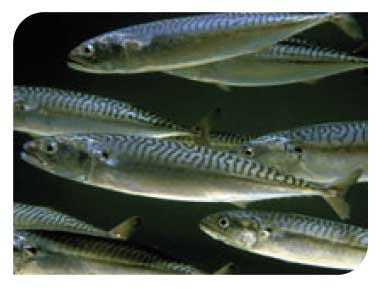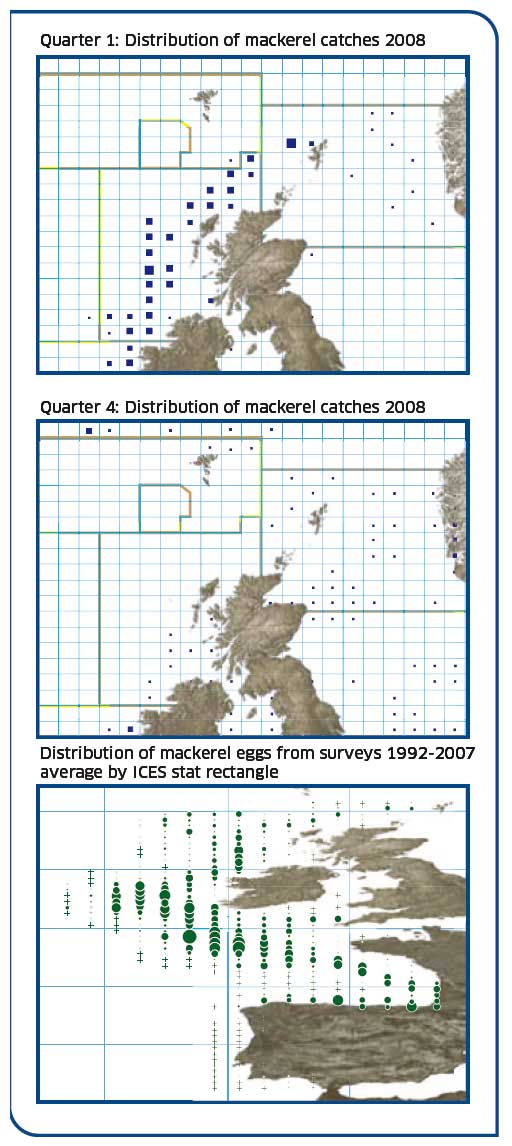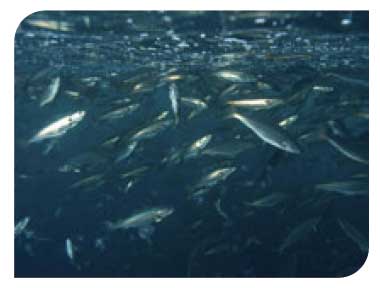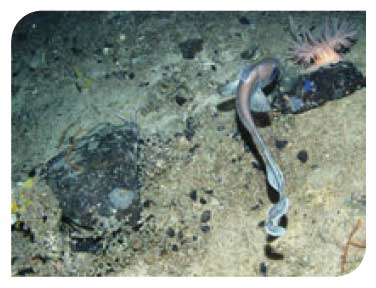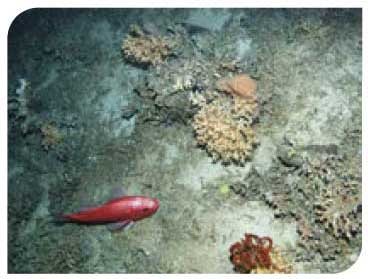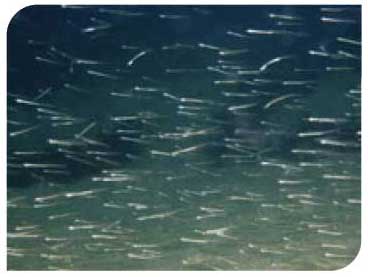Scotland's Marine Atlas: Information for The National Marine Plan
Scotland's Marine Atlas is an assessment of the condition of Scotland's seas, based on scientific evidence from data and analysis and supported by expert judgement.
COMMERCIAL FISH AND SHELLFISH STOCKS
The seas around Scotland support significant populations of commercially important species of fish and shellfish. Overall landings in Scottish ports and catches in Scottish waters are detailed in Chapter 5 - Fishing. The fish cover a diverse range of species falling into two broad categories. Pelagic species such as mackerel and herring move about throughout the water column while demersal species such as cod and haddock spend most of their life in close proximity to the sea bed. The distribution of most of these stocks extends over quite wide areas, frequently into waters where they are also fished by other countries. Assessments of the state of stocks are performed internationally by the International Council for the Exploration of the Sea ( ICES), thus reporting at the scale of the Scottish sea areas used in this Atlas is not possible. Assessments of fin fish stocks are instead provided here according to three area descriptions: i) widely distributed stocks located right around Scotland and often close to the shelf edge (200m depth) ii) North Sea stocks and iii) West of Scotland stocks.
Data on commercial catches and from scientific surveys are collected by Scotland and other nations and combined in the assessment process to provide estimates of the size of the stock (measured as the spawning stock biomass, SSB), the numbers of young fish entering the fishery (recruitment) and the rate of removal by fishing (fishing mortality rate, F). ICES scientific advice is provided in a framework which judges the state of each stock against precautionary reference points for biomass (Bpa) and fishing mortality rate (Fpa). Where possible, stocks included here are noted as above Bpa and below Fpa. Recently, ICES has provided advice in relation to long term maximum sustainable yield ( MSY). A four panel plot is included to show where each stock is placed with respect to this. A third measure, in the form of a percentile bar chart, is provided to give a broad indication of trends in SSB and F. These plots show the percentage of stocks which are in a worse state, same state or better state in the most recent 10 year period compared with the previous 10 years.
Anglerfish
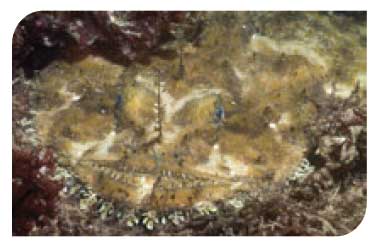
© Paul Kay
The scientific advice is used to inform the management processes under the EU Common Fisheries Policy and for a number of the finfish species of interest to Scotland, stocks are also shared with countries outside the EU (for example Norway). Amongst the measures presently used in management the principal ones are total allowable catches ( TAC - shared out into quotas for each country), effort control and technical measures (for example fishing net mesh sizes). Scientific advice on these measures is provided by ICES, consistent with the frameworks described above.
In recent years a positive development has been that of long term management plans ( LTMP) which are designed to help recovery and subsequently maintain stocks in a healthy condition and may incorporate mechanisms which assist industry such as limits on catch variability. Scottish stocks subject to such plans have generally performed quite well in recent years. For some stocks, however, high exploitation rates in the 1980s and 1990s led to marked declines in stock biomass and the emphasis of recent management has been to help their recovery. Most notable are a number of the cod stocks in the North-east Atlantic, including the North Sea and West of Scotland. Cod recovery plans have been in place for a number of years and have been the main driver for effort regulation. So far stock improvements have been limited, although in the North Sea mortality has fallen since 2000 and there has been a modest increase in biomass. In Scotland a new and innovative approach, 'Conservation Credits', has been in place since 2008 which rewards fishermen for avoiding cod. Various tools are employed such as real time closures and gear measures and the process is co-managed with industry. So far this has helped to reduce the amounts of cod discarded by Scottish vessels.
Widely distributed stocks
A number of commercially important stocks are distributed widely around the north and west of Scotland. The most important of these include two species (mackerel and blue whiting) which are taken in extensive international pelagic fisheries and four demersal species: anglerfish and megrim are taken in more recently developed specialist fisheries of growing importance to Scotland; saithe has been fished for many years and now provides an increasingly important contribution to Scottish vessels' earnings; and hake, which has become more abundant in Scottish waters recently. The state of several of these stocks for which there are accepted ICES assessments shows a generally positive picture for two thirds of them with fishing mortalities in line with MSY and precautionary approach principles and healthy biomasses. An additional widely distributed stock, Atlanto-Scandian herring which is fished by Scotland but well to the north of Scotland is also being fished sustainably. The current state of blue whiting, however, gives cause for concern and a series of poor recruitments following irresponsible management by certain coastal states has reduced the stock size to below precautionary limits. In common with the other widely distributed stocks, blue whiting is now subject to a LTMP and providing the recommendations of this are followed by all Contracting Parties, stock improvement is expected to follow. ICES assessments for anglerfish and megrim are in a developmental stage and reference points against which to measure the states of these stocks are not presently available. Nevertheless, results from joint industry/ science surveys indicate recent increases in the megrim stock and a generally stable anglerfish abundance.
State of widely distributed stocks
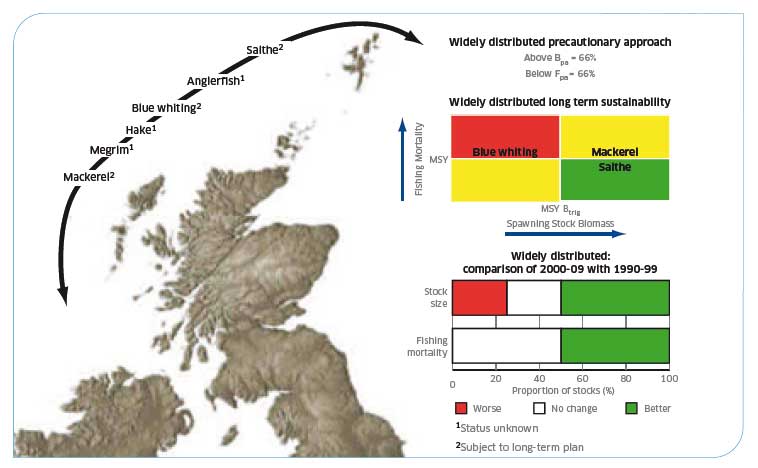
Source: Marine Scotland - Science
Note: black arrow indicates distribution of named stocks
Mackerel
Amongst the widely distributed stocks, the western mackerel is commercially the most important. Catch information is in Chapter 5 - Fishing. This stock exhibits migratory behaviour that extends its distribution from the Iberian peninsula to waters north of Scotland and a number of countries participate in the internationally managed fishery. The migrations give rise to seasonality in the fishery with catches occurring mainly from the west of Britain in quarter 1 (January - March) shifting to the north of Scotland and west of Norway in quarter 4 (October - December). Assessment of this stock is complex and relies heavily on an internationally coordinated survey of egg numbers from which a back calculation estimates the stock size. The core of egg production occurs in the waters to the west of Britain.
The mackerel stock is currently in good condition and the recent results from the 2010 egg survey indicate a marked increase in stock biomass. A number of good recruitments, together with implementation of a sustainable long term management plan, has led to a biomass well above precautionary limits and the stock is fished just above Fmsy. The continued health of the stock depends on adherence to the plan and observance of the agreed catch limits.
Mackerel
|
Mackerel stock - distribution of catches and egg production
Size of green dot and blue squares is proportional to abundance. |
Saithe
|
North Sea stocks
Some of the most important and long standing Scottish fisheries are located in the North Sea prosecuting stocks which are distributed principally in this area. Most of the important fish stocks are shared with other EU member states and Norway and a number are subject to long term management plans. Scottish whitefish fishing effort (mostly by trawl and seine net gears) is distributed mainly in the northern parts of the North Sea particularly towards the shelf edge; a significant proportion of this effort occurs in the Norwegian sector, as shown by the blue shading in figure below. Accepted ICES assessments are available for five of the six main stocks and the states of the stocks present a mixed picture when compared with MSY targets and precautionary reference points. Herring, haddock and plaice are fairly close to Fmsy targets while cod and sole are being fished above sustainable rates. In terms of precautionary reference points the position is more positive and 80% are fished appropriately. In the case of stock biomass only 40% are above the precautionary approach level.
When compared to the previous 10 year period, the most recent 10 years have shown reductions in the rate of fishing of all assessed stocks in the North Sea but a less positive picture on stock biomass which has only improved in a third of cases.
The whiting stock continues to present assessment challenges and its condition is not known. Regional differences in abundance have led to the suggestion that more than one stock may be present, this would confound the process of estimating stock trends.
Successes in bringing fishing mortality down and maintaining it at appropriate levels in a number of stocks may be attributed to LTMPs and the continued development of these is seen as key to ensuring sustainability. In the case of the cod stock the challenge is bigger, requiring a significant rebuilding of the stock; from 2005 onwards a slightly larger year class has led to some increase in the stock biomass. The agreement for a cod recovery plan led to the implementation of stringent Europe wide measures to reduce fishing mortality, with member states subjected to reductions in fishing effort. The plan provides scope for measures other than effort to be used to reduce mortality and Scotland has developed a unique scheme which encourages cod avoidance including the use of real time closures and selective gears. In return for complying with the scheme, some effort is granted back to the fishermen. So far this has led to marked reductions in cod discard rates by Scottish vessels.
Cod
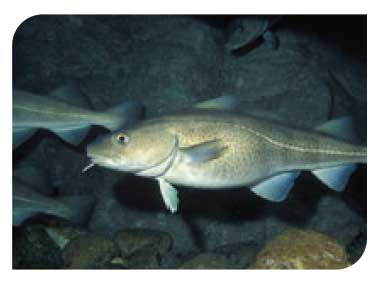
© Paul Kay
Atlantic herring
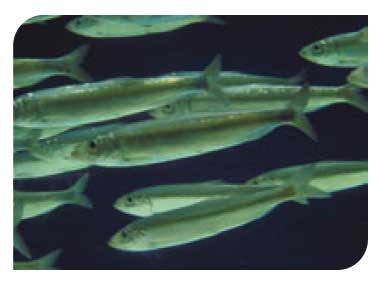
© Marine Scotland
West of Scotland stocks
On the west coast of Scotland the fish stocks are also in various states and the overall picture is less positive than in the North Sea. The distribution of Scottish whitefish effort close to the shelf edge on the west coast is even more pronounced than in the North Sea. Information with which to judge the state of these stocks is only fully available for three of the stocks. The two haddock stocks, VIa and Rockall are fished close to Fmsy, but the stock size of the former continues to give cause for concern. The cod stock remains in a very poor condition and like the North Sea stock is subject to the cod recovery plan. Here, however, there has been little response and stock biomass remains too low. West coast herring, subject to a LTMP, is being fished at a broadly sustainable rate but the lack of biomass reference points prevent a judgement on stock size. Information on the west coast whiting stock is very sparse but all indications are of a stock in very poor condition. The stock trends plot suggests that while there has been some progress in reducing F over recent years, it is not so striking as in the North Sea and also the position on stock biomasses has deteriorated, with 50% in a worse condition.
State of stocks - west of Scotland and North Sea
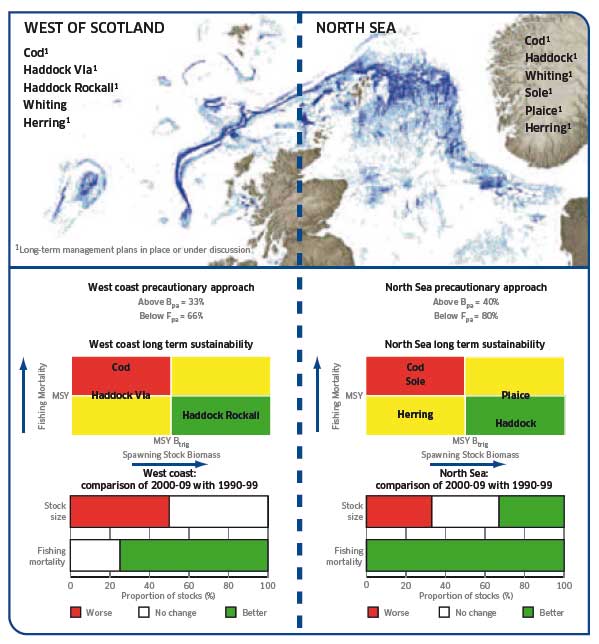
Shellfish
Shellfish species also support valuable fisheries in Scotland. Nephrops, scallops and edible crabs represent almost one third of the value of all landings by Scottish vessels in 2009. Many of these species contribute to important export markets in Europe and worldwide. See Chapter 5 - Fishing, for more detail.
With the exception of squid species which are highly mobile, shellfish species are sedentary and live on the sea bed. Different species have different benthic habitat requirements and species distribution is heavily dependent on the availability of suitable substrates. The geographical distribution of different habitats around Scotland is highly complex, especially on the west coast, and as a consequence shellfish species populations are distributed patchily but in discrete aggregations. For many species numerous stocks can be identified and where possible these are assessed separately. Although the centres of distribution of many of the shellfish stocks do not align perfectly with the boundaries used in this Atlas, it is nevertheless possible to say more about the state of local stocks in different parts of Scotland than it is for the fish stocks.
Crabs and lobsters
Several species of shellfish are fished using baited creels, these include edible crabs, velvet swimming crabs and lobsters. Unlike fish, these crustacean species cannot be aged and so assessments make use of length composition data. The assessments provide an indication of the state of exploitation of the stock and whether or not increased yields could be expected by fishing at a reduced rate and leaving the animals in the sea for longer in order to allow them to grow. Potentially, management measures can be applied on the basis of these results to reduce mortality and allow the animals to grow before capture. At present, the main management measure for crab and lobster is use of the minimum landing size. Edible or brown crabs are distributed on cobble and gravely substrates which occur around the Scottish coasts. Traditional inshore fisheries in the south east of Scotland and the various island groups have in recent years been overtaken by new developments in slightly more offshore areas to the north and west of Scotland. Most edible crab stocks are fully exploited or overexploited. Stocks to the north and west of the Hebrides are presently underexploited. Velvet crabs and lobsters are widely distributed in more rocky areas. Lobster stocks are either fully or over exploited and a recent maximum landing size has been introduced in an effort to protect large mature females to try to enhance egg production. The fishery for velvet crabs is a more recent development beginning on the west coast and now extending to most areas, the state of exploitation is quite variable and a number of stocks remain underexploited.
Scallops
The second most valuable shellfish species, scallops is distributed widely over sandy and gravely substrates and assessments are available for four of the stocks. This species can be aged and conventional age based assessments supplemented by scientific surveys provide indications of stock trends. Stocks to the west of Scotland currently exhibit declining biomass and reduced recruitment while those to the east are fluctuating without an obvious trend. The healthiest stock appears to be in Shetland waters.
Nephrops
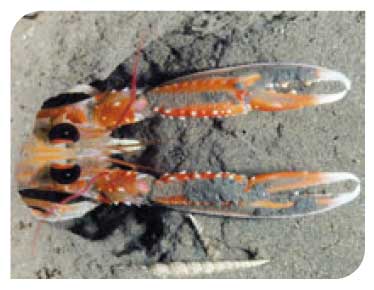
© Paul Kay
State of shellfish stocks
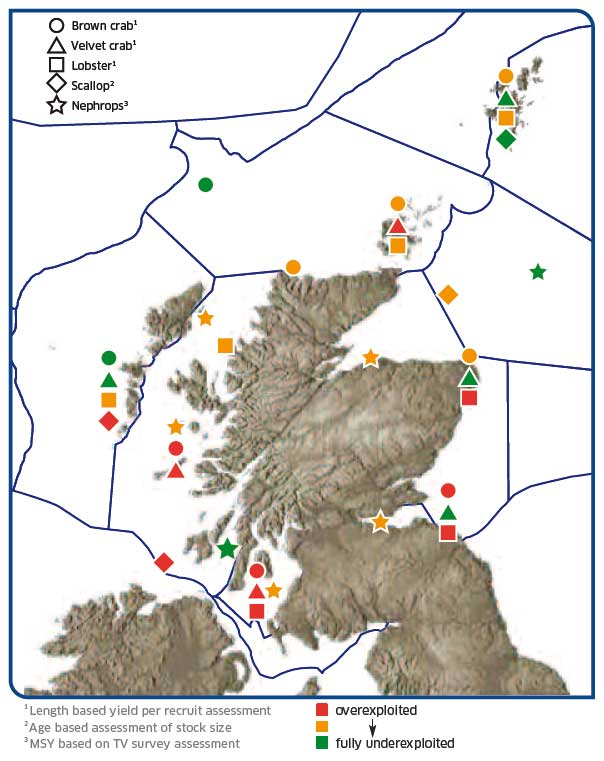
The most valuable shellfish species (and sometimes the most valuable commercial species overall to Scotland) is the Norway lobster, Nephrops. This species is distributed in all areas where soft mud and sandy mud occurs. These areas dominate most of the firths of Scotland and extensive areas of the west coast. In more recent years a major fishery has developed at the offshore Fladen Ground in the North Sea and this is now the biggest Nephrops fishery in the world. Nephrops fisheries are prosecuted by a large fleet of generally smaller vessels using otter trawls and on the west coast there is an extensive creel fishery. Trawl activity is shown by the blue shading in the figure to the right. The patchy distribution of Nephrops gives rise to a number of separate stocks or functional units which are assessed using underwater television camera techniques. Estimates are made of the population size by counting the numbers of burrows in which the animals live. On the west coast the three stocks (North Minch, South Minch and Clyde) are reasonably stable but are fished slightly above Fmsy. In the North Sea, the Moray Firth and particularly Firth of Forth, are also fished above Fmsy while the Fladen Ground is being fished at a rate below Fmsy. In all cases the biomasses appear to be healthy. A smaller stock, the Noup, exists to the North of Scotland although its state is not known.
The overall assessment of shellfish stocks broadly suggests that those in the south and west are heavily exploited, compared to stocks in the more northerly and easterly parts of Scottish waters which show signs of a general improvement with more examples of under-exploited stocks.
Scallop
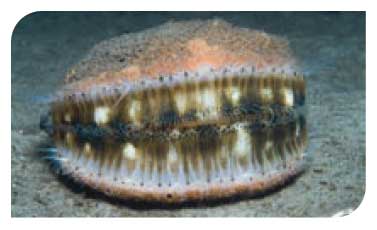
© Paul Kay
Scallop dredger
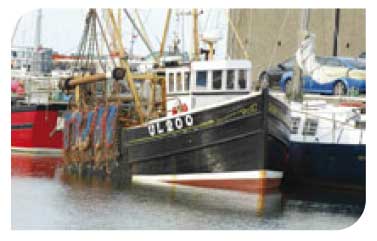
© John M Baxter
Nephrops abundance in Scottish stocks
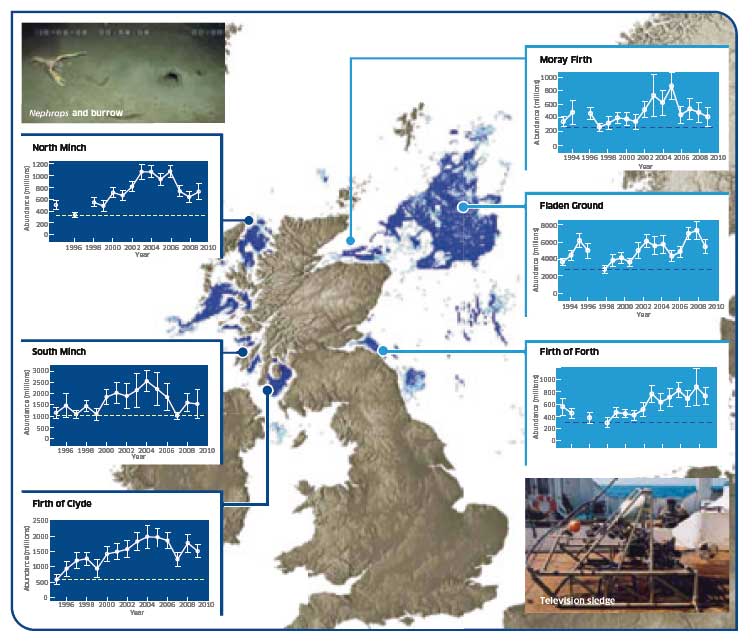
Conclusions
- There are a number of distinct fisheries in Scottish waters exploiting a wide variety of species.
- The states of stocks of fish presents a mixed picture across and within regions.
- More data are needed on a number of stocks to provide reliable assessments.
- Considerably more data/research would be needed if future reporting was to be carried at the scale of Scottish sea areas.
- There is a mixed picture in terms of current state and future prospects of different industry sectors.
- Overall, trends in fishing mortality levels in relation to precautionary limits show significant improvement.
- In general, trends on fish stock size are more mixed. Of particular concern are West of Scotland demersal stocks which are at very low levels.
- The diversity and variable states of shellfish stocks presents a very mixed picture across the various regions with a tendency for lower exploitation in the north and east.
- Of the stocks for which estimates of Fmsy are available, about 33% are already being fished at this rate.
Creels on quayside at Stromness, Orkney
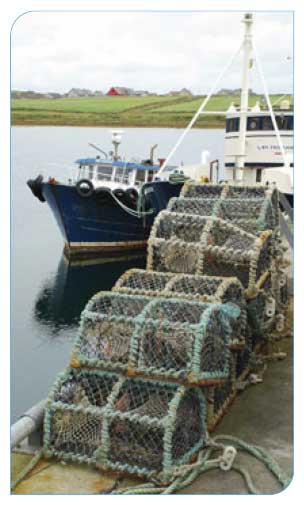
© John M Baxter
Priority Marine Features
Species |
Sea area |
Status |
|---|---|---|
Anglerfish |
Territorial waters and offshore |
High risk species taking many years to reach maturity. North sea stock in decline, ICES continue to recommend a reduction in fishing effort and catch. West coast stock stable. |
Atlantic halibut |
Offshore |
Slow growing and late maturing. Seriously affected by overfishing and recognised as Endangered on the IUCN Red List. |
Atlantic herring |
Territorial waters and offshore |
An important food fish for many other species, ICES considers stocks currently managed sustainably in the North Sea. |
Atlantic mackerel |
Territorial waters and offshore |
Western mackerel stocks considered of regional and possibly global importance. North Sea stock still to fully recover from decline in 1960s. |
Black scabbardfish |
Offshore |
Slow growing, long-lived, late maturing susceptible to overfishing. ICES advise no expansion in fishery. |
Blue ling |
Offshore |
Slow growing, long-lived, late maturing susceptible to overfishing. Stock status uncertain, ICES advise no directed fishery. |
Blue whiting |
Offshore |
Poor recruitment since 2005 has led to declining stocks, ICES consider it to be harvested above Fmsy. |
Cod |
Territorial waters and offshore |
Stocks severely declined, ICES consider stocks in the North Sea, western Scotland and Irish Sea below safe biological limits. Listed as Vulnerable on IUCN Red List. |
European hake |
Offshore |
Status cannot be assessed accurately but increasing since 1999 and believed to be within safe biological limits. |
Greenland halibut |
Offshore |
Long-lived and slow growing, susceptible to overfishing. Current stock status unknown. |
Horse mackerel |
Offshore |
Numbers fluctuate depending on scale of annual recruitment. ICES advise that fishery should not expand. |
Ling |
Territorial waters and offshore |
Scotland has a large proportion of British population, numbers are maintaining a stable low level. |
Norway pout |
Territorial waters and offshore |
Recruitment is variable but fluctuations in North Sea stocks probably natural rather than due to fishing pressure. |
Orange roughy |
Offshore |
Very slow growing, very long-lived, vulnerable to overfishing. ICES advise the fishery is unsustainable in the North-east Atlantic. |
Round-nose grenadier |
Offshore |
Slow to reproduce and susceptible to overfishing, currently overexploited. |
Saithe |
Territorial waters and offshore |
Stocks recovering and thought to be fished sustainably. |
Sandeel Ammodytes spp. |
Territorial waters and offshore |
Stocks are in decline, an important food fish for many species of seabirds. |
Whiting |
Territorial waters and offshore |
Stocks have been stable or declining for last 10 years, and North Sea distribution contracted. |
Round-nose grenadier
|
Orange roughy
|
Sandeels
|
There is a problem
Thanks for your feedback
